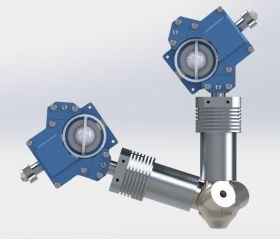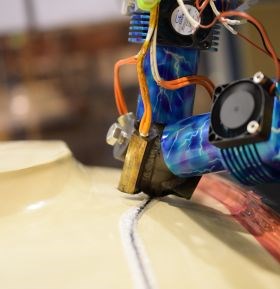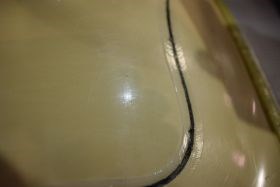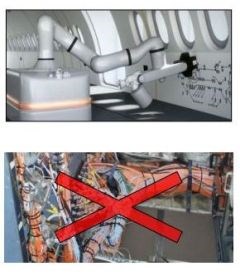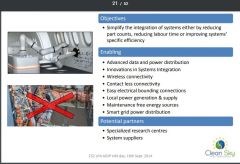3D-printed composite wind blades and aircraft, closer than you think
Orbital Composites’ patented coaxial extrusion process is investigated at Airbus subsidiary CTC GmbH Stade and spins off advances in speed, scale, materials and multifunctionality as it aims for very large structures.
From early work building carbon fiber reinforced plastic (CFRP) drones, Orbital Composites CEO Cole Nielsen wanted a better, faster means of manufacturing. Based in Silicon Valley, it’s not surprising that he and fellow employees opted for a different approach. “It took over a year just to identify the right questions,” says Nielsen. From there, they deconstructed every part of the conventional fused deposition modeling (FDM) process used to 3D print continuous fiber composites and redesigned it, including new hardware (and software) in order to achieve dramatic new capabilities:
- Printing large areas (rotor blades, aircraft wings, car parts) with high resolution.
- Printing fast — up to 100X faster than current continuous fiber-reinforced plastic technologies.
- Printing dry, bindered fiber from 3k to 48k tow.
- Printing fiber coextruded with plastic, ceramic or metal matrix materials including thermosets, thermoplastics and silicon carbide.
- Printing in multiple materials, including copper or aluminum wire, nanomaterials and/or conductive inks, to achieve the multifunctional structure desired.
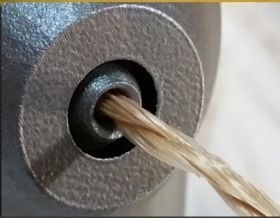 |
|
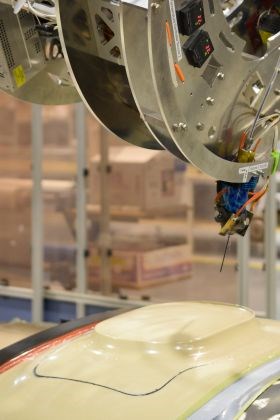 |
Orbital Composites’ patented coaxial extrusion printing are being tested to produce continuous fiber composites onto curved surfaces and also offer the disruptive ability to print with wires and other elements for multifunctional composite structures.
SOURCE: CTC and Orbital Composites.
Coaxial Extrusion
“The central bore in the coaxial extrusion nozzle is the fiber nozzle, rounded to avoid abrading the fiber,” explains Nielsen. An annular nozzle around the fiber nozzle extrudes the matrix. “The coextruded composite can be driven into the previous print layer to consolidate and debulk. The outer region of the nozzle has an extended flat zone surrounding it. This is used like an iron to compress the matrix sheath (thermoplastic, thermoset, etc.) into the fiber and smooth the extruded sheath into the previous passes that the tool has made.”
Nielsen’s team is material agnostic. “We want these coaxial systems to adapt to a wide variety of feed materials,” he says. “Ideally, we design a toolset around the composite materials the customer selects. This allows the customer to ensure its certifications and feed material supplies. For additive manufacturing to become a dominant process, material prices must be at a minimum.”
“In some cases, thermoplastic composites for example, end use parts may be fabricated directly from the coax nozzles.With ceramic precursors and sinterable bound powders, however, post-processing — such as pyrolysis and silicon infiltration — will be required.”
Nielsen notes the coaxial extruders can also be used to make fiber preforms for overmolding or compression molding. “We want to be as adaptable to the various material choices and composite manufacturing chains as possible. That is why our nozzles are so modular.”
“Orbital Composites intends to erase the line between 3D printing and automated fiber placement,” says Nielsen. “With respect to that goal, our tools operate within the open source interface standard for the 3D printing (3DP) industry. There are 16mm groove mounts enabling our modular approach.” He also points out vocabulary that illustrates one part of the company’s novel approach. “The 3DP community call 'extruders' what Orbital Composites calls 'filament drivers'. We find our term more accurate. In injection molding jargon, an 'extruder' would include both the nozzle and drive mechanism combined.”
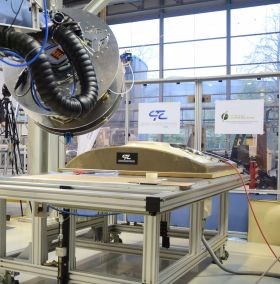 |
Successful tests at CTC have included printing of continuous CF/PA66 composite onto curved, 3D shaped molds using CTC’s first Orbital Composites system.
SOURCE: CTC and Orbital Composites.
Development with CTC
The Composite Technology Center (CTC, Stade, Germany) was originally part of Airbus Stade Research & Technology (R&T) Group, spun off as a subsidiary of Airbus Operations GmbH in 2001 (see my CW Plant Tour article on CTC). It operates at the forefront of developing composites technology and began working with Orbital Composites in February 2017 after reading an article on its coextrusion printhead. “We exchanged ideas on how to improve 3D printing with continuous fiber composites,” says Johannes Born, R&D engineer at CTC and manager of the development program with Orbital Composites. “We decided to test their equipment in an Evaluation Phase project, which started in April 2017. After a lot of constructive discussion about the printhead design and print materials, Orbital delivered it to CTC in September.”
CTC used this system to perform a series of very successful tests and make internal presentations, including engineers from the Airbus 3D printing community. (Note, San Jose, CA, US-based venture capital fund Airbus Ventures has invested $150 million into Local Motors’ 3D printed car technology. Read “Airbus Ventures Invests in Local Motors to Shake up Aerospace Industry”.) “These were very successful
“CTC’s part in this project is mainly offline programming of the robotic equipment and the assessment of the capabilities with regard to aerospace applications,” explains Born. “We are still testing this equipment, but have already purchased a second system with an improved setup. We have switched to a smaller printhead and instead of using with a universal robot, it will be installed in a dedicated print cell. This will be delivered by Q1 2018.” He notes trials to date have included carbon fiber and polyamide 66 (PA66). “The next steps are to explore matrix systems that meet mechanical and temperature requirements as well as flame, smoke and toxicity (FST) requirements for aircraft interiors,” says Born.
 |
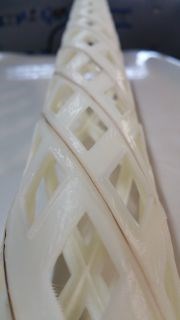 |
 |
CTC’s first Orbital Composites system features three different print toolheads mounted onto a carousel end effector for a universal robot arm (bottom left). Separate successful trials have also included printing copper wire/ABS composites. SOURCE: CTC and Orbital Composites
“We are definitely interested in printing larger parts,” says Born. “This is a new approach because we are not slicing the part. We are starting from a CATIA drawing and using that to plan the fiber deposition process. With one click, we extract the fiber path for the robot [aka, “G-code” used in computer aided manufacturing for automated machines]. This keeps the process simple and enables true 3D placement of fiber, including placement onto curved surfaces.” He adds that with the Orbital Composites technology, “we can work with both a prepregged filament and a non-prepregged fiber. The latter is lower cost. It also has drawbacks because you are doing impregnation at the nozzle. So we continue to look at both.”
What about print resolution? “The resolution of a single Orbital Composites coaxial extruder scales from E3D’s Volcano Nozzle to to BAAM [Big Area Additive Manufacturing] because we are limited by the robot accuracy and by the 2-mm nozzle diameter. If you look at competitors on the market (like MarkForged), their printer has a 0.2mm nozzle diameter, which gives you their resolution, but they are limited in part size. Their roving is also ≈1K fiber, so the highest price material for input. Orbital’s approach is to use the right nozzle where we need it. For example, you need higher resolution for assembly surfaces. But there are also areas of the part where we don’t need that resolution.”
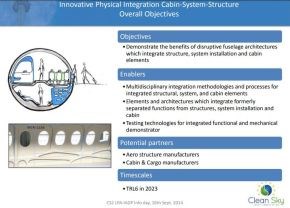 |
Look Familiar?
Orbital Composites and CTC PA-wire composites demonstrator (top left) bears a striking resemblance to the illustration from the Clean Sky 2 program’s Innovative Physical Integration Cabin-System-Structure work package. (Click to enlarge)
SOURCE: CTC, Orbital Composites and Clean Sky 2 Joint Technical Proposal.
Printing with wire
“We are still evaluating printing with wires,” says Born. “We know of the Clean Sky 2 projects but we are not working on these. Still, our technological targets are the same.” Will printing with wire work? “I think it is possible, but there is still much development to do. If it works, it will be a game changer. There are business cases for parts 3D printed with carbon fiber alone. But there are many more cases if we can integrate electrical or data systems and/or lightning strike protection into these parts. There are also a lot of issues as to how to qualify parts that serve both structural and systems functions, but that is for the next phase of development.”
Speed
“We want to build useful structures more quickly,” says Nielsen. “A print nozzle can push and melt only so much plastic, so you can only go so fast. In traditional FDM, you melt the entire extrudate. This isn’t necessary with fiber Coaxial Extrusion, so our systems can move more material with less heat work. We have high-pressure, matrix-blending nozzles from two years of trial and error.”
He claims a single Orbital Composites filament driver + coextrusion nozzle can increase speed 5X vs. standard FDM at the same resolution. “But if you drop resolution to 2mm (vs. 0.2mm for MarkForged), you can add another 5X increase,” Nielsen explains. “So now we’re at 10X standard FDM. If we then merge five nozzles together, we start multiplying, not adding. So this is how it is possible to achieve rates that are 50-100 times faster than FDM.”
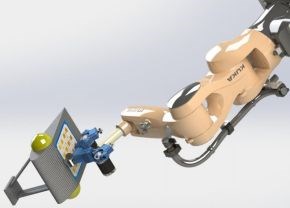 |
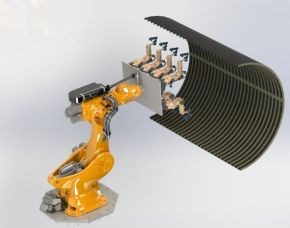 |
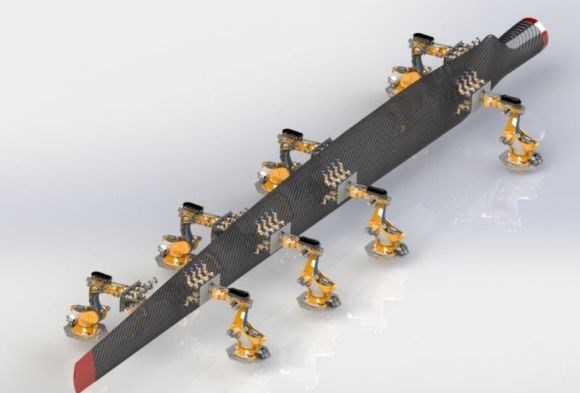 |
|
Fractal Robotics
Top left, “Finger”: Kuka arm with single Orbital Composites coaxial extrusion toolhead.
Top right, “Hand”: Kuka Titan with 8-10 Orbital coextrusion “Fingers”
Bottom: Many “Hands” make light work of large composite structures.
“The concept of fractal robotics is analogous to the evolution in computer processing,” explains Amolak Badesha, an early investor and strategic advisor at Orbital Composites. “A decade ago, Intel processors would double their speed every 2-3 years. But they reached a limit in fabrication where this was no longer possible. So they developed quad- and eight-core parallel processors which enabled further increases in computing speed. This approach was advanced to yet another level by producing graphics cards with hundreds of these cores to achieve speeds of 50, 100 and 200 times what a novel single-core processor could achieve. This fundamental breakthrough in computing power unlocked tremendous advances not only in graphics performance but also in super-computing and Artificial Intelligence applications. Our Fractal Robotics approach is the same, taking what you are used to doing with a large, central machine and breaking that into a multi-resolution process completed in parallel at a significantly faster rate. Our vision is to 3D print large, high-performance composite structures at speeds significantly faster than what is possible today.”
“3D printing companies want to build the best ‘box’, and AFP machine manufacturers want the largest, fastest machine,” adds Nielsen. “But we are breaking that paradigm apart and processing much more material, much more quickly with parallel processing.” Just like each finger moves independently in a human hand, each of the 8-10 toolsets in the Orbital Composites “hands” move independently from the rectangular base plate on the large orange Kuka in the image above.
Reliability — Scalability — Mobility — Mission
Actualizing these three characteristics in 3D-printed, continuous fiber composites is Orbital Composites’ mission.
RELIABILITY
“We must have self-loading, error-correcting automated manufacturing cells to achieve full-cycle, stand-alone industrial operation. Nothing like this exists in the world of Automated Fiber Placement,” says Nielsen. “Modern automotive manufacturing is a miracle. That’s the optimal model. Millions of absolutely identical units are fabricated in highly automated systems. We need to shift the paradigm in aerocomposite manufacturing to the automotive model.” Imagine, the near complete 3D printing of multifunctional composite vehicles.
SCALABILITY
Orbital Composites nozzle resolutions scale up and down — 10mm diameter for low-resolution and faster output to 0.4mm for higher resolution, but slower output) — the fibers can range from 3k to 50k. The individual coaxial nozzles can be stacked together, like pixels, to change the print grid resolution. Robotic motion systems scale via fractal robotics and break the resolution-time barrier. “These points of scalable integration enable building large items, at a high resolution, in a reasonable amount of time,” says Nielsen.
MOBILITY
”Mobility,” Nielsen explains, “enables large composite structures to be printed onsite or on a ship, for example.”
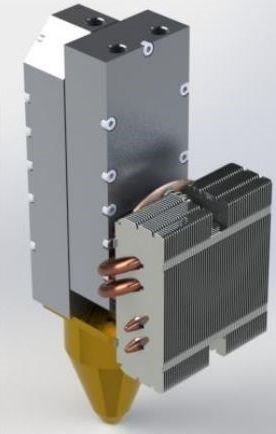
Orbital Composites has developed a printhead for epoxy composites which mixes the two resin components and also prevents exotherm. SOURCE: Orbital Composites.
“We are raising capital to build the largest composite structures in the world,” he continues. Why? “To demonstrate the power of Coaxial Extrusion,” Nielsen replies. “Orbital will pursue funding in stages and will continue to develop and sell custom nozzles and integrate printer cell systems. We are providing that service to help develop the industry state of the art, and we want feedback from people who aren’t afraid of developing new tools. I see a very dense subsystem variety in what Coaxial Extrusion will ultimately achieve.” He gives examples of applications including CFRP 3D structures with: pick & place drop-in components like RFID chips and inkjet-printed integrated circuitry, printed-wire interconnects, multi-functional meta-material elements, etc.
“We are developing print nozzle toolsets tailored for specific materials and target parts,” says Nielsen. “We have developed thermoplastic print nozzles that hit over 650C and are compatible with PEEK composites. Other nozzles for epoxy composites that are being used in an industrial setting.” The company is also developing manufacturing cells that are adaptable to a variety of materials and part requirements. For all of these print nozzles and toolsets, Orbital Composites also completes the robotics integration. The entire system is being mobilized.
MISSION
“Orbital manufacturing – building vehicles and large structures in space– is my ultimate goal personally,” says Nielsen. “We’re developing a system which can be put into orbit to mass produce drones, satellites and humanity’s largest ever structures — an orbital factory that can build the equipment that SpaceX and others need for missions to Mars and beyond by shattering the restrictions of launch weight, volume, and vibration. That vision has not changed, but we need to be a company building the largest composite objects, on Earth first. A reliable, scalable, mobile system is our mission.”
Related Content
Composites manufacturing for general aviation aircraft
General aviation, certified and experimental, has increasingly embraced composites over the decades, a path further driven by leveraged innovation in materials and processes and the evolving AAM market.
Read MorePlant tour: Albany Engineered Composites, Rochester, N.H., U.S.
Efficient, high-quality, well-controlled composites manufacturing at volume is the mantra for this 3D weaving specialist.
Read MoreCompoTech uses integrated loop technology to create high-performance mountain bike
CompoTech features its CDuro Epona mountain bike fitted with custom suspension forks, manufactured using its AFL winding and integrated loop technologies.
Read MoreNanopoxy, Nione jointly develop nanostructured epoxy resin
Epoxies featuring nanometric niobium pentoxide particles promote toughness, UV radiation resistance and other performance gains.
Read MoreRead Next
Plant tour: Daher Shap’in TechCenter and composites production plant, Saint-Aignan-de-Grandlieu, France
Co-located R&D and production advance OOA thermosets, thermoplastics, welding, recycling and digital technologies for faster processing and certification of lighter, more sustainable composites.
Read MoreAll-recycled, needle-punched nonwoven CFRP slashes carbon footprint of Formula 2 seat
Dallara and Tenowo collaborate to produce a race-ready Formula 2 seat using recycled carbon fiber, reducing CO2 emissions by 97.5% compared to virgin materials.
Read More“Structured air” TPS safeguards composite structures
Powered by an 85% air/15% pure polyimide aerogel, Blueshift’s novel material system protects structures during transient thermal events from -200°C to beyond 2400°C for rockets, battery boxes and more.
Read More




